Abstract
Aiming at the low-frequency oscillation problem of high-proportion wind power and energy storage connected to the power system, this paper establishes a system small signal model according to the matrix similarity theory, which lays a foundation for the research on oscillation characteristics, mechanism analysis, and suppression measures. Combined with the different installation positions of the inverter-side converter and the inverter-side POD (Power Oscillation Damper) controller of the energy storage device, the suppression mechanism and damping oscillation ability of the two on low-frequency oscillation were analyzed. Under multiple optimization objectives, the parameters of the damping controller are optimized by Pareto and improved particle swarm algorithms. Finally, through Matlab/Simulink simulation, the effectiveness of the Pareto and improved particle swarm algorithm in suppressing low-frequency oscillation of the system is verified.
1. Introduction
In recent years, with the increasingly prominent ecological and environmental problems, energy consumption has become increasingly tense, and the development and utilization of renewable new energy has become an important strategy for the sustainable development of World energy resources. Wind energy, as a clean, renewable, and pollution-free green energy, is the fastest-growing and fastest-developing renewable energy in the world. According to the Chinoiserie Wind Power Development Roadmap 2050 issued by the Energy Research Institute of the National Development and Reform Commission and the International Energy Agency (IEA), by 2050, wind power will reach 1 billion kilowatts, meeting 17% of domestic power demand.
With the increasing penetration rate of wind power, its operational characteristics have an undeniable impact on the safety and stability, peak shaving, frequency regulation, and economic operation of the power system. On the other hand, the inherent characteristics of wind energy and the immaturity of wind power planning and control technology are constraining the further development of wind power. Firstly, the planning and consumption of wind power grid connections are issues. The uneven distribution of wind resources in China has led to excessive wind energy in some regions, and the problem of “wind abandonment” is serious. However, through the large-scale construction of ultra-high voltage and direct current transmission networks, the rapid development of distributed generation and microgrid technology, the problem of “wind abandonment” has been solved; Secondly, there is the security and stability issue of the power grid after large-scale grid connection of wind power. Wind energy itself has intermittent, fluctuating, and anti-peak characteristics, and wind turbines differ from traditional synchronous generators in terms of structure and control strategies, which can pose a potential threat to the stability of the regional power grid with high permeability of wind power and affect the power system’s power grid scheduling and peak shaving frequency regulation.
The large-scale development of wind power is imperative, but due to the randomness of wind energy, wind power generation has certain volatility [1]. On a long-term scale, wind power output fluctuates irregularly with changes in wind speed, while on a short-term scale, wind power output suddenly changes or even disappears. The intermittency and volatility of wind power make the output power of wind power extremely unstable. Maintaining a balance between power generation and load supply and demand is a key concern for maintaining the stability and reliability of the power system. The power system with a high proportion of wind power lacks the inertia and damping [2] provided by synchronous generators (SGs) in traditional power systems, which changes the oscillation characteristics of the system and cannot guarantee the stable operation of the power system.
Low-frequency oscillation (LFO) in the power grid generally refers to the weakly damped oscillation process between 0.1–2.5 Hz. The lower the oscillation frequency, the more serious the consequences on the stability of the power system.
Adding POD to wind turbines increases damping by controlling their output. The control effect of POD may exacerbate the oscillation of DFIG (Doubly Fed Induction Generator) [3] itself, threatening its stability. Therefore, this article takes into account the negative impact of POD on DFIG, introduces relevant safety constraints, reasonably plans and allocates frequency modulation tasks, and maintains the operational safety of DFIG while suppressing oscillation [4].
Adding a POD to the ESS is to increase the damping by controlling the output power of the energy storage.ESS (Energy Storage System) has the advantages of fast response speed and bidirectional power regulation, which can effectively improve the output characteristics of wind farms and suppress wind power fluctuations. Large-scale energy storage optimizes the operational performance of wind power connected to the power grid by suppressing wind power fluctuations or shifting the time and space of the grid load, thereby improving the stability of system operation, reducing the peak valley difference of power system load, and improving power quality and supply reliability. Installing ESS for wind farms is an effective way to improve the characteristics of wind power generation and improve the coordination performance between sources and networks.
Among many energy storage methods, battery energy storage uses Redox to store and release electric energy, which has the characteristics of fast response, high efficiency, long life, convenient installation and configuration, and low cost. It is the most widely used energy storage method at present. In recent years, the research of battery Energy storage technology, especially large capacity battery energy storage, has been changing with each passing day, the control technology has been continuously improved and innovated, and the cost of energy storage has been constantly reduced. The application of battery energy storage in the field of wind power control will usher in greater opportunities.
The causes of low-frequency oscillation include rapid changes in wind speed, tower mechanical oscillation, and control dynamic interaction, etc., which can be analyzed based on external monitoring or internal modeling, using negative damping, bifurcation theory, etc. From the perspective of the power grid, the weakly damped LFO is often derived from the dynamic interaction between the internal controls of the SGs. The grid-connected DFIG and SG control strategies interact with each other, which may aggravate the low-frequency oscillation. Installing SGs a power system stabilizer (PSS), improving the PSS control strategy and control parameters, and adding wide-area control to high-voltage DC, flexible AC, energy storage and other equipment, can also suppress LFO. The difficulty lies in the control algorithm and coordinating with each other. The basic idea of suppressing LFO is to increase system damping, including adding PSS to SG, optimizing control parameters of DFIG [5], adding POD to DFIG, and adding flexible AC transmission systems (FACTS) and high-voltage DC(HVDC) with POD, etc. [6].
In the frequency regulation task of the power grid, the synchronous machine has a slow response but still bears the main role of frequency regulation. The rapid response of the inverter can provide short-term support and a conservative bottom line. The two need to work together and jointly for frequency regulation. This article focuses on the research of wind turbine inverters and energy storage inverters. The imbalance of active power is the inherent driving force behind low-frequency oscillation in the power grid, so inverters must provide active support to suppress the fluctuation of active power in the power grid system, thereby quelling low-frequency oscillation in the power grid [7].
This article first takes the wind storage joint grid connection system as the research object and establishes a wind storage system model; secondly, it analyzes the suppression strategies of wind storage systems for low-frequency oscillations. The main contribution is the installation of POD on the side of the Double-fed Induction Generator machine side converter and the installation of POD on the energy storage side converter, and adjusting the frequency based on the frequency trajectory planning method. Finally, a simulation model is built in Matlab/Simulink 2019 simulation software to verify the effectiveness of the proposed suppression strategy through simulation.
The paper is structured as follows: the modeling and analysis of wind storage systems are presented in Section 2, the control strategy for suppressing low-frequency oscillation in wind storage systems is discussed in Section 3, and in Section 4 the Pareto-based controller parameter optimization is presented. In Section 5, the simulation verification and conclusions are presented.
2. Modeling and Analysis of Wind Storage Systems
2.1. Modeling of Wind Farm and Analysis of Its Working Characteristics
Double-fed induction generator (DFIG) is a new type of generator based on traditional synchronous and asynchronous generators. However, unlike asynchronous generators, it has a three-phase excitation winding structure on the rotor side. Unlike synchronous generators, the rotor side is fed with variable frequency AC. In actual operation, the rotor speed of a doubly fed generator, coupled with the rotational magnetic field generated by the rotor excitation current, is equal to the synchronous speed of the rotor, thereby inducing an induced electromotive force at the synchronous frequency on the stator side.
Figure 1 shows the basic structure diagram of DFIG, with the stator side connected to the power frequency grid and the rotor side connected to the grid through a partial power converter. By controlling the rotor side converter, the excitation current frequency, amplitude, and phase of the rotor winding are controlled to ensure stable power output on the stator side, while decoupling the rotor speed from the system frequency. The relationship between DFIG rotor speed and system frequency is as follows:
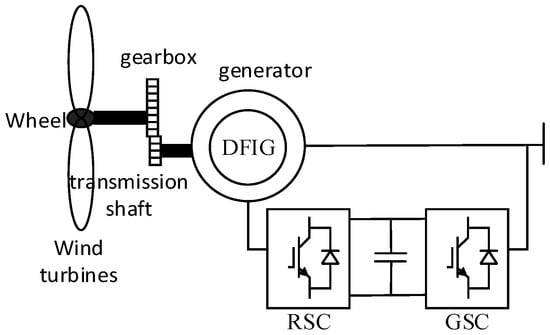
Figure 1.
Basic structure diagram of doubly fed wind turbines.
is the rotor speed, and is the system frequency.
The mechanical power captured by DFIG is:
where is the Density of air; is the wind energy utilization coefficient, which is related to the tip speed ratio and the pitch angle ; is the area swept by the wind turbine rotor; is the wind speed; is the mechanical speed; is the radius of the wind turbine.
is represented as:
In the equation C1, C2, C3, C4, C5 and C6 are constants.
Figure 2 is the verification of the maximum power tracking characteristics of DFIG, and the output power of DFIG is affected by the change of pitch angle and wind speed. With the direction of the arrow on the right, it represents a gradual increase in wind speed, corresponding to the power tracking curve at the wind speed. The maximum power point tracking (MPPT) of the wind power generation system means that the wind turbine can obtain the maximum power output under any circumstances, that is, the wind energy can be converted into electrical energy to the maximum extent.
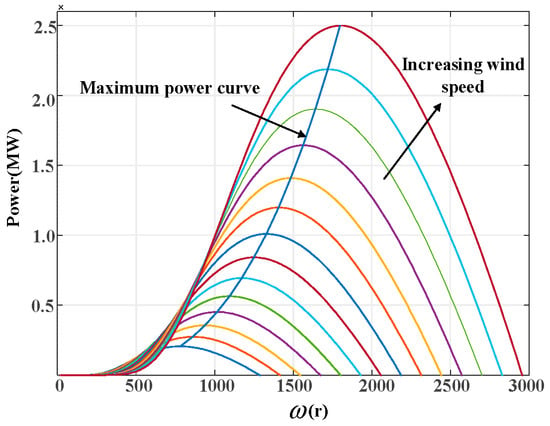
Figure 2.
Control strategies for DFIG: characteristic for Maximum Power Point Tracking.
DFIG consists of pitch angle control (2nd order), wind turbine and transmission system (3rd order), induction motor (4th order), DFIG back-to-back converter, and DC capacitor model (9th order) [8].
If the wind speed goes beyond the rated limit, it’s important to ensure that the power absorbed by the wind turbine remains the same. This is because the wind turbine’s mechanical strength and converter capacity have their limitations. To limit the aerodynamic efficiency of the wind turbine blades, the pitch angle is controlled. Thus, the wind turbine model uses a pitch angle control system, which can be represented by an equation as follows:
In the equations: is the pitch angle; is the reference value of the pitch angle; is the time constant of the pitch angle control system; , is the proportional and integral parameter of the PI link to obtain the given value of the pitch angle from the rotational speed; is the generator rotor speed; is the reference value of generator rotor speed. In the modeling of doubly fed wind turbines, using dual mass blocks is more effective in describing the mechanical characteristics of the DFIG shaft system in detail than using single mass blocks. Therefore, the wind turbine and low-speed shaft are treated as one mass block, and the gearbox and high-speed shaft are treated as another mass block. The torsion between multiple mass blocks in DFIG will generate shafting oscillation [9], and the shafting model of the two mass modules is:
In the equations: is the angular velocity of the wind turbine; is the rotor speed of the double-fed asynchronous generator; is the torque angle of the transmission shaft; , are the inertial time constants of the wind turbine and the double-fed asynchronous generator; is the output torque of the wind turbine; is the electromagnetic torque of the double-fed asynchronous generator; K is the stiffness coefficient of the shaft system; D is the damping coefficient; and is the reference value of the speed.
If the electromotive force and the d, q axis current of the stator are selected as the state variables after the transient reactance is decided, the dynamic equation of the doubly fed induction motor can be expressed (See Appendix A for the specific derivation process):
where in
In the equation, the subscripts and represent the and axis components; The subscripts and represent the stator side and rotor side components, respectively.
The electromagnetic torque of a doubly fed induction motor is described as:
is the electromagnetic torque of the motor, is the synchronous speed of the motor, is the direct axis current component of the motor rotor winding, is the quadrature axis current component of the motor rotor winding, are the d, q axis transient potential of the stator windings. The vector control on the side is synchronized in the d-q coordinate system, and the direction of the d-axis is consistent with the direction of the stator flux. At this time , the stator winding voltage drop is ignored, and the direction of the stator magnetic field lags behind the stator voltage by 90°. So :
Similar to the machine side, the direction of the reference coordinate system’s d-axis is consistent with the grid voltage, and the q-axis is 90° ahead of the d-axis. Set the d-axis in the direction of the grid voltage space vector, with . So the active power and reactive power output by the grid side converter are:
In the equation, and are the d and q axis components of the grid voltage; and are the d and q axis components of the grid side converter current, respectively; and are the d and q axis components of the grid side converter voltage, respectively.
This article assumes that both the stator and rotor sides adopt the motor convention. The control objective of RSC is to achieve decoupling and independent control of active and reactive power on the stator side by controlling the excitation voltage. The control block diagram on the RSC side is shown in Figure 3, and the dynamic model is as follows:
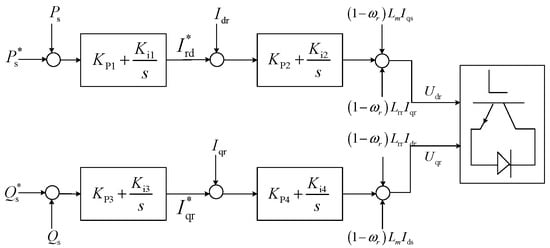
Figure 3.
RSC Side Converter Control Block Diagram.
The output voltage is:
In the equation, , , respectively, represent the proportional gain and integral gain in the PI parameters, ,, , are intermediate state variables introduced in the control loop.
The control objective of GSC is to stabilize the DC link voltage and maintain the constant power factor operation of the main network. The control block diagram of the GSC side is shown in Figure 4, and the dynamic model is as follows:
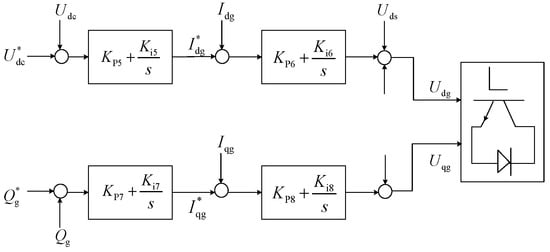
Figure 4.
GSC Side Converter Control Block Diagram.
The output voltage is similar to the machine-side converter, and the dynamic model of the control part of the energy storage converter is similar to the fan-side, which will not be repeated here.
The dynamic model of the DC side of the intermediate capacitor is:
The synchronous generator includes the second-order rotor Equations of motion, the first-order rotor electromagnetic transient equation, the first-order excitation system equation, and the first-order speed governing system equation. This article studies the characteristics of low-frequency oscillation, ignoring the prime mover and its speed control system. The dynamic differential equation is described as:
In the equation, is the generator rotor angular velocity, is the synchronous angular velocity of the generator rotor, is the inertia time constant of the generator rotor, is the damping torque coefficient of the generator, is the mechanical power of the prime mover, is the electromagnetic power of the generator; is the time constant of the excitation winding; is excitation electromotive force for the generator; is the transient electromotive force of the generator; and is the synchronous reactance and transient reactance of the stator; and is the gain and time constant of the excitation system; and are the terminal voltage and its reference value of the synchronous machine.
2.2. Modeling of Stand-Alone Infinity Systems with Wind Storage
There are two ways for wind storage to connect to the power grid: distributed and centralized. Distributed access refers to each wind turbine motor being equipped with an energy storage device, which requires a small energy storage capacity and flexible compensation. However, it requires multiple sets of control devices and is complex to install; Centralized access refers to the installation of a set of energy storage devices at the entry point, which requires a large energy storage capacity. However, only one set of control devices is needed, making it easier to centrally control. Moreover, the output of each wind power is not exactly the same, and there is partial complementarity. Centralized access has a higher utilization rate of energy storage. This article adopts a centralized access method, connecting the energy storage device to the grid-connected bus of wind power, which can effectively improve the acceptance capacity of wind turbine grid-connected power generation, and achieve power compensation and peak shaving and valley filling.
Figure 5 shows the grid-connected model of the wind storage system, which mainly includes SG, wind turbine, ESS, and infinite grid.
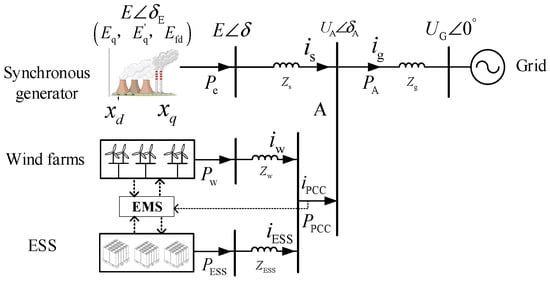
Figure 5.
Wind Storage System Model.
In the wind storage integrated power plant, battery ESS auxiliary wind power is connected to the grid, which is jointly determined by the wind power output and ESS Co-determination.
The system power balance equation is:
In the equation, the positive and negative represent the charging and discharging state of the energy storage, the positive represents the energy storage discharge, and the negative represents the energy storage charging.
Analysis shows that the power balance of the system can be achieved through power control of wind turbines and ESS.
This article analyzes the operation and related characteristics of the wind energy storage joint system. Based on the output characteristics of the doubly fed wind turbine power generation and the complementary operation characteristics between multiple types of hybrid ESS energy storage, the operation control strategy for the grid connection of the wind power hybrid energy storage joint system is analyzed.
The active output power of synchronous generators are:
2.3. Linearized Equivalence Model of Stand-Alone Infinity System with Wind Storage
To analyze the low-frequency oscillation stability of the wind storage grid connected system under disturbance, the eigenvalue analysis method can be used to linearize the system [10] near the operating point. According to the matrix similarity transformation theory, the state matrix of the original system has the same eigenvalues as the similarity matrix, and the stability and oscillation mode information of the original nonlinear system at the operating point can be obtained by solving the equation of the Linear system. Establish the equations of state [11] and algebraic equation of the wind storage grid connected system:
where is a Differential operator;, is an Equation of state and Algebraic equation, respectively; , is a state variable and an algebraic variable, respectively.
By linearizing the above two equations at steady-state operating points, a linearized model of the wind storage grid-connected system can be obtained [12]:
In the equation, , , , are coefficient matrices; is the system state matrix; represents increment. From , information such as oscillation mode, damping ratio, frequency, and participation factor can be calculated.
Let the conjugate eigenvalue of the oscillation mode be , and the damping ratio and oscillation frequency of the system be:
The left and right eigenvectors and related to the eigenvalues are defined as as participation factors, representing the degree of influence of the state variable on the oscillation mode. For the low-frequency oscillation problem studied in this article, it is necessary to study the roots of the strong correlation between and , and define the electromechanical circuit-related participation factor of the mode as:
Based on the results of small signal analysis, inter-region oscillation modes can be identified, and damping control can be carried out using a POD controller. At the same time, the controller gain should be adjusted reasonably so that the controller can not only increase inter-region damping but also have a positive effect on oscillation in other modes.
3. Control Strategy of Wind Storage System to Suppress Low-Frequency Oscillation
3.1. Evaluation Indicators for Oscillation Degree
The rotor motion of a synchronous generator reflects the frequency dynamics of the power system, as shown in Figure 6. The blue arrow part is the maximum speed deviation . When low-frequency oscillations occur in the power grid, the SG rotor will continue to oscillate, causing the generator speed to change and deviate from the initial speed . The indicators for measuring the dynamic characteristics of the rotor include the speed change rate and the speed deviation , among them, mainly affect the fatigue degree of the mechanical spindle, and mainly affects the speed protection of the unit.

Figure 6.
Dynamic characteristics of SG rotor speed during low-frequency oscillation in the power system.
The swing of the SG rotor follows the Equations of motion of rotor:
where and are, respectively, the mechanical power and electromagnetic power of SG, and are Moment of inertia.
As shown in Figure 6, the longer the oscillation time of the rotor, the larger the oscillation area, and the greater the impact on the frequency quality of the power grid. The calculation equation for the rotor oscillation area is as follows:
In the equation, and , respectively, represent the starting and ending times of the rotor deviating from the synchronous speed. It can be seen that the longer the continuous oscillation time of the power grid, the greater the , and the greater the impact on the frequency stability of the power grid.
In conclusion, the influence of the unbalanced power of the suppression system on the synchronous machine speed mainly considers three aspects: restraining , avoiding rotor machine fatigue and equipment accidents; suppressing and avoiding unit stall or overspeed protection; suppressing and avoiding excessive oscillation time and amplitude.
However, in practical applications, most countries’ power grids have regulations on the frequency offset and rate of change of frequency (RoCoF) of the power grid, rather than the changes related to rotor speed. When the frequency is 60 Hz, the lower limit of frequency protection is 59.3 Hz, that is, the frequency offset is 0.7 Hz, and the frequency change rate is constrained between 0.12 Hz/s and 1.2 Hz/s. The measurement of RoCoF is generally based on the tangent of a given point on the frequency response curve, estimated through frequency measurements of 0.1–0.5 s in a short period of time. The time window for calculating the RoCoF of wind farm integration points should be greater than 100 ms and less than 200 ms.
3.2. Design of Power Oscillation Damper
Power oscillation damper (POD). In the nonpeak load stage, some SGs are replaced by wind power, and the original stable control strategy of SGs may not be feasible. To achieve this [13], POD can be installed on DFIG to achieve similar functions as SG-PSS, and damping can be increased by controlling DFIG output. The control structure of POD is shown in Figure 7, which consists of four modules. The first module is the POD amplifier gain unit, the second module is the isolation link, and the third and fourth modules are both lead modules or both lag modules. The phase compensation link provides the necessary lead (or lag) characteristics to compensate for the phase lag (or lead) between the slip input and the electrical torque of the generator. This paper uses two first-order links. In practice, more first-order links or second-order links are needed to achieve the ideal phase compensation effect. Among them, the gain unit is used to enhance mode damping; The isolation link is used for filtering [14], filtering out steady-state components, and the POD output is zero when the signal changes to steady-state; The lead-lag module is used for phase compensation, compensating for the phase shift of frequency measurement and filtering links at low-frequency oscillation frequencies, ensuring that damping control plays a positive damping role without the need for external power grid information [15].

Figure 7.
Structure diagram of POD controller.
The feedback signals for suppressing oscillation modes in POD mainly include two types: the rotor speed (or grid frequency) and the power angle of the generator. This article combines two types of feedback signals, using the change in bus voltage phase angle information of the coupling node port of the wind storage system, and obtaining the change in synchronous electrical angular velocity through a filter, replacing the traditional SGs as the input of the POD. This reduces the synchronization problem of the wide-area measurement system receiving speed signals, shortens the response time of the modulation output active power, and unifies the POD feedback signals of the wind turbine and energy storage.
The mathematical expression for the power oscillation damper is [16]:
where , , , , and are control parameters, is the sensor time constant, s is the Laplace operator, is the transfer function of POD, and is the angle of phase compensation.
The gain coefficient of the POD controller directly affects the damping effect of the controller. When selecting, the output compensation power capacity constraint should be considered to ensure that it does not exceed the total output of the wind storage system. At the same time, the impact of the controller output power on the synchronous machine terminal voltage should be considered to ensure that its fluctuation value does not exceed the limit. Therefore, under these two constraints, the control coefficient with the most obvious damping effect can be selected through frequency domain analysis.
3.3. Analysis of the Influence of Different Installation Positions of POD on Low Frequency Oscillation
The inverter mainly includes the installation of POD on the RSC side of the doubly fed fan and the installation of POD on the energy storage side of the inverter.
The dual PWM controller can achieve bidirectional energy flow. When the doubly fed fan operates in a subsynchronous state, the energy flows from the grid side to the rotor side of the doubly fed fan; When the doubly fed fan operates in a super synchronous state, energy flows from the rotor side of the doubly fed fan to the grid side.
RSC mainly realizes decoupling control of output active and reactive power, while GSC mainly realizes control of input power factor and DC voltage stabilization [17].
According to the control object, POD can be divided into active control, reactive control, and active/reactive hybrid control. POD can achieve different functions and different oscillation suppression effects when installed in different positions, and can suppress oscillation amplitude when installed in a rotor side converter (RSC); The grid side converter (GSC) installed on the grid side can speed up the Rate of convergence speed of oscillation. Usually, LFO is more sensitive to than , , or and installing reactive power control in the GSC circuit can reduce voltage quality to a certain extent [18].
The control block diagram corresponding to the mathematical model of the doubly-fed windmill converter described above is shown in Figure 8 below [19]:
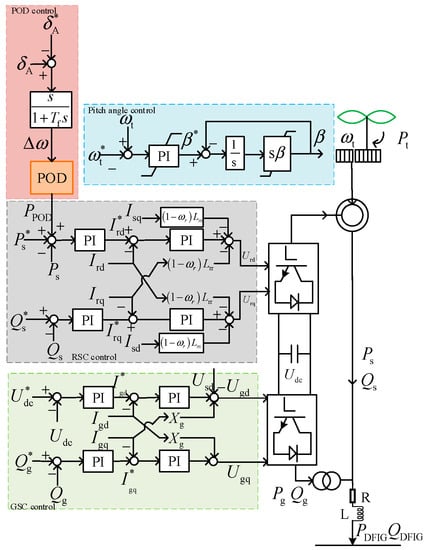
Figure 8.
Control Structure Diagram of DFIG with Additional POD.
Renewable energy has become a feasible solution to the problems of global energy security and environmental degradation. Due to the mature technology of wind power generation and low investment cost, wind power has developed rapidly, and the amount of wind power generation has been increasing exponentially year by year. However, like other renewable energy sources, wind energy is uncertain and uncontrollable. This uncertainty has brought adverse effects on ensuring grid stability, reliability and power quality. Existing methods for mitigating wind power fluctuations can be divided into two categories, namely power smoothing methods without ESS and methods using ESS. The cost of pitch angle control and inertial kinetic energy control in the first method is low, but its adjustment speed is slow; it is limited by wind speed and wind power penetration rate, causing the adjustable range of fan output power to be small. In the second type of method, ESS is added to the wind power generation system, which can not only stabilize the fluctuation of wind power, but also quickly make up for the system power shortage with the maximum output power in a short period of time; it can also reduce the limitation of wind turbine capacity and increase the output power adjustable range. Due to the technological development of ESS, it is widely used in alleviating wind power fluctuations and suppressing system frequency oscillations. This paper adopts the second method, and ESS can quickly and massively contribute to make up for the power shortage caused by the sudden increase in system load.
Energy storage suppressing low-frequency oscillation provides positive damping for the frequency oscillation of the system. When low-frequency oscillation occurs in the system frequency, energy storage dynamically adjusts its active output based on the frequency change of the system. Its control methods mainly include droop control, inertia control, and maximum power output.
Figure 9 shows the control strategy of ESS to suppress low-frequency oscillations of the power grid in the wind storage system, which mainly includes synchronous generators, doubly fed fans, ESS, and an infinite grid. is the electromagnetic power of the synchronous machine; is the active power output by the doubly fed fan; is the active power output by ESS; , are the output currents of the d and q axes in the dq coordinate system, respectively; , are the command values for the output current of the d and q axes, respectively [20].
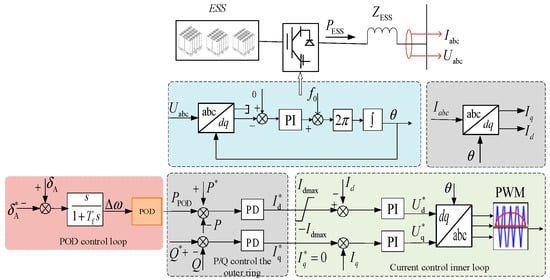
Figure 9.
ESS with additional POD control strategy to suppress low-frequency oscillations in power grids.
The active output current of ESS output is shown in Figure 9:
In the equation, , is the gain of the PD controller in the speed loop. For low-frequency oscillations in the power grid, existing control strategies mainly include inertia control and droop control; is the synchronous Angular frequency, and is the measured Angular frequency of the power grid. Assuming that ESS only provides active support and does not consider the impact of reactive power on the system, the set value of reactive current is always zero.
Expression for electromagnetic power increment of synchronous machines at the electromechanical time scale:
In the equation, is the synchronization coefficient of the power grid, representing the synchronous and stable operation ability of the power system itself; is a control parameter for energy storage, characterizing the impact of ESS on the dynamic characteristics of the power grid under the control strategy. So when the power grid oscillates, the electromagnetic power of the synchronous machine will change.
If the active power injected by ESS into the power grid is taken into account, the damping coefficient and inertia coefficient of the power system are:
In the equation, D and H are the inherent damping and inertia coefficients of the system.
According to the above equation, the Mode of action of the P controller is equivalent to droop control, and the D controller is equivalent to inertia control. Therefore, droop control suppresses by enhancing the positive damping of the power system, while inertia control mainly suppresses by enhancing the inertia level of the power system. The above two types of control can directly or indirectly affect , thereby achieving suppression of low-frequency oscillations in the power grid.
When the unbalanced power in the system is large, it is necessary for the ESS to release (absorb) enough energy in a short period of time, which may exceed the capacity setting of the inverter. At this point, even if the control parameters of inertia control and droop control are adjusted, it is difficult to meet the suppression of low-frequency oscillation, and it is necessary to enable the energy storage to output at maximum power in nonlinear control mode.
When the power grid operates in a steady state, the mechanical power is equal to the electromagnetic power . When load disturbance occurs, the system energy is surplus, and the power absorbed by the wind storage device is , so the equations of motion of the synchronous generator rotor are:
When the wind storage system is in the maximum power modulation state, is obtained from Equation (32):
At the initial moment of oscillation, the wind storage system power has not changed, , and the maximum speed change rate at this time is:
Taking inertia control as an example, the output of ESS under inertia control does not exceed the capacity limit , namely:
So the gain of the D controller can be obtained from Equations (34) and (35):
The Equations of motion of the rotor in the ESS inertia control mode are obtained by bringing Equation (36) into (32) and (35):
Obtain the synchronous machine speed change rate under inertia control as
By subtracting from (33) and (38):
So the wind storage system is at maximum power output on under maximum power modulation is better than that of inertia control.
4. Pareto Based Controller Parameter Optimization
4.1. Multi-Objective Optimization Based on Pareto Algorithm
Multi-objective optimization problems refer to problems that require simultaneous optimization when multiple objectives cannot be met simultaneously. It is difficult to achieve optimal results for multiple objectives under constraint conditions, but rather to obtain a set of Pareto optimal solutions that converge infinitely to the true Pareto frontier and are uniformly distributed. The elements in the set are called Pareto optimal solutions or non-inferior solutions. When studying the suppression of low-frequency oscillations in the power grid, the key is to combine decision information with the optimization process to obtain a satisfactory compromise solution.
The traditional method adopts a decision-before optimization approach, where decision-makers first assign weight values to each objective, transforming multi-objective problems into single-objective problems. In recent years, with the development of various algorithms, there has been a method of optimization before decision-making, which involves first finding the multi-objective Pareto optimal solution set during the optimization process, and then selecting the optimal solution of one or more multi-objective problems from the Pareto optimal solution set by decision-makers according to specific decision-making methods.
Pareto domination: For any two decision variables a and b:
(1) Pareto domination: a domination b: a < b, if and only if any i, there is and i exists, such that .
(2) There is no difference between a and b: , if and only if and If the decision vectors a and b are Pareto-dominated, then all objective function values of decision vector a are less than or equal to all objective function values of decision vector b.
Pareto optimal solution: The decision variable is called Pareto optimal solution, any , .
Pareto optimal set: The set of all Pareto optimal solutions.
Optimization objective:
Total output power of each unit
Frequency offset:
Frequency change rate:
F1, F2, F3 are objective functions. is the active power, is the variation of frequency, and is the variation of time.
The optimal solution sorting method based on the Pareto dominance relationship classifies population solutions and allocates individual fitness values. For individuals in a population , it is necessary to calculate the number of dominant solutions and the set of dominated solutions . The optimization process for the optimal solution set of the fitness function is as follows:
Step 1: , ;
, , ;
, ;
, , .
Step 2: , , , if , ;
, , ;
, .
Step 3: If , the loop ends. Otherwise, move on to step two.
Q is a non-empty set.
4.2. Further Optimization Based on Improved Particle Swarm Optimization Algorithm
The PSO algorithm is used to search for the optimal parameters [21] in the POD controller and solve for the optimal parameters in the Pareto algorithm’s optimal solution set. The main idea is to determine the adaptability of each particle in each generation by constructing several groups of particles and setting a fitness function. Then, compare the fitness values of each particle in each generation to obtain the global and local best particles. Finally, based on information sharing between particles, update the direction and velocity of each particle. The effectiveness and searchability of this method are related to population size, algebra, and fitness function design. This program can be summarized into the following four steps.
Step 1: Initialize population attributes: Each particle’s position contains n dimensions, corresponding to n control parameters in the POD controller. The initial velocity value of particle swarm optimization is formed by experience. The Particle number and iterations are both set to 50, the gain search range is set to [−10,10], where the search range of the time constant and is set to [0.01,0.5], and and are set to [0.01,0.9]. The state attributes of particle i are as follows:
Current position of particles: .
Current velocity of particles: .
Step 2: Calculate the fitness function, and update the individual best and global best: After initialization, the position of each particle is sent as a parameter value to the POD controller, and the simulation is run using the F function to obtain the fitness value.
The optimization objective of this article is to minimize the fitness function. is the time range of oscillation, is the output error. The individual and global best particles will be determined based on the fitness of each particle.
Step 3: Update speed and position: The speed and position of each particle in its next state should be determined based on individual extremum, global extremum, and the speed and position of the previous state.
In the equation, is the inertia weight; represents the current speed; and are acceleration constants (learning factors), usually taken as 2; and are uniformly distributed random numbers in [0,1]; is the individual optimal position of the i-th particle; is the current global optimal position.
The equation consists of three parts. The first part, , is the memory part of the particle, which explains the velocity of the particle’s previous state; the second part, , is the cognitive part of particles, which determines their global search ability and prevents algorithms from falling into local optima; the third part is the social learning part of particles, reflecting the group learning process of information sharing between particles.
Step 4: Determine whether to complete the program: If one of the following termination conditions is met, the optimization process will be completed.
(1) The maximum number of iterations has been reached.
(2) The fitness value of the global optimal solution is less than the set value, which is called iterative convergence.
If neither of these situations is met, the program returns to the second step.
Compared with another Evolutionary algorithm, PSO can quickly converge to the optimal solution and is immune to the local optimal solution. It has a simple principle, fewer parameters, and is easier to implement.
To reduce the probability of the algorithm falling into the local optimum and improve the fitting accuracy, this paper proposes a new improved Particle swarm optimization (NIPSO) algorithm, which mainly improves the inertia weight and the learning factor , .
The inertia weight expresses the degree to which the current particle search speed affects the subsequent particle speed, affecting the local and global search capabilities of the PSO algorithm. The traditional method of fixing inertia weights has limitations, as there is no oscillatory convergence in the later stage, which is not conducive to the comprehensive and detailed optimization of the algorithm. Therefore, this article adopts a nonlinear decreasing inertia weight factor approach for algorithm optimization.
In the equation, is the maximum number of iterations, is the current number of iterations, and are the initial and final values of the inertia weight, with values ranging from [0.4,0.9].
The learning factors and , respectively, control the self-cognition and social learning parts of particles. The ideal particle swarm algorithm has a global search ability in the initial stage to avoid falling into local optima; In the later stage, it emphasizes convergence to a local minimum, with a fast Rate of convergence and high convergence accuracy. Therefore, in the initial stage of the algorithm, particles need to have a large self-cognition and a small social learning part, and in the later stage, they need to have a small self-cognition and a large social learning part. However, the traditional PSO algorithm has limitations in setting a fixed learning factor. This article dynamically adjusts the learning factor based on the number of iterations:
In the equation, and are the initial and final values of the learning factor, with values ranging from [1,3].
The algorithm flowchart is shown in Figure 10:

Figure 10.
Optimal Solution Sorting Method Based on Pareto Dominance Relationship.
5. Simulation Verification
In this paper, Matlab/Simulink simulation software is used to verify the influence of the proposed control strategy on the low-frequency oscillation characteristics of the system, and the infinite system model shown in the figure is constructed and the simulation is performed, and the system parameters are shown in Table 1.

Table 1.
Active power of each power generation unit in the simulation model.
In the model, the active power of each power generation unit is shown in the table, the structural parameters of the doubly-fed fan are shown in Table 2, the parameters of the energy storage converter are shown in Table 3, and the loads are 49 MW, 6 MW, 24 MW and 12 MW, respectively. In addition, the doubly-fed fan adopts additional POD combined with maximum power tracking control, and the energy storage part adopts additional POD combined with sag control and maximum power output control.

Table 2.
Structural parameters of doubly-fed fans.

Table 3.
Main parameters of energy storage converter.
Taking a 2 MW energy storage converter as an example, the main parameters are shown in Table 3.
In the negative damping state, the system amplified oscillation caused by low-frequency oscillations is shown in Figure 11:
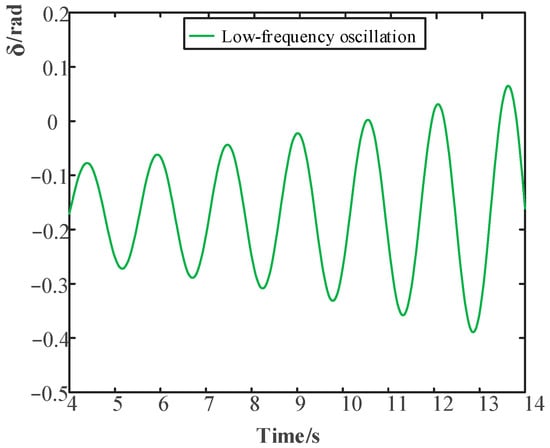
Figure 11.
Power Angle Variation When Out of Synchronization.
After the wind storage system is connected to the grid, based on the analysis of the power system characteristics of the wind storage system, the change of low-frequency characteristic values before and after the grid connection is shown in Figure 12. It can be seen that the wind storage grid connection system is connected to the grid to reduce the damping ratio of some modes, and a new oscillation mode is introduced. Table 4 shows the influence of LFO under weak damping before and after wind storage is connected to the grid. The focus is on oscillation suppression at the minimum damping ratio (0.03). In order to display the image clearly, only the characteristic roots of the second quadrant of the complex plane are shown, and the conjugate characteristic roots that are symmetrical about the real axis in the third quadrant are omitted.
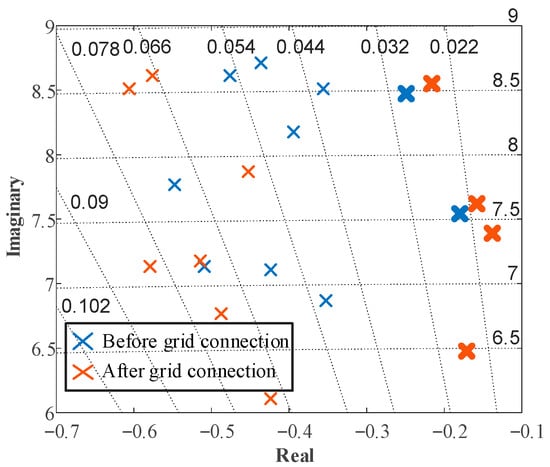
Figure 12.
Characteristic values of wind storage system before and after grid connection.

Table 4.
Influence of wind storage system on LFO of power system under weak damping.
Low-frequency oscillations mostly occur in large-area and cross-area power grids with weak connections. This type of instability is mainly caused by weak damping and negative damping. The strength of system damping can be judged by the damping ratio of several dominant oscillation modes. It is generally believed that when the damping ratio is greater than or equal to 0.1, the system damping is strong; when the damping ratio is less than 0.03, it indicates that the system damping is weak; when the damping ratio is less than or equal to zero, it indicates that the system damping becomes negative, and constant amplitude oscillation will occur. Therefore, only the characteristic roots below the damping ratio of 0.03 are considered, that is, the bolded part in the above figure.
The initial parameters of the POD are set to 10, to 0.2, to 3, to 0.5, to 0.1, to 0.05, and to 0.07. Taking the POD installed on the RSC side of the doubly-fed fan as an example, the results of the POD controller parameters of the traditional particle swarm algorithm and the improved particle swarm algorithm are shown in Table 5:

Table 5.
Comparison of POD parameters.
The doubly-fed fan and energy storage are connected to the grid at the same point, and a small load disturbance is added at the 4 s, and the original load is restored at the 8 s. According to the optimization parameters, the parameters of the POD control part are adjusted, and the active power output of the wind storage system is observed, as shown in the figure. As the ESS has not reached its maximum output power, the calculation of its overshoot should take the maximum output power as a reference value, so it does not affect the system stability. Moreover, the ESS can increase the output to make up for the power shortage caused by the sudden increase of the system load, accelerate the power angle oscillation amplitude of the synchronous machine to approach zero, and significantly enhance the system stability. As can be seen from Figure 13, under the controller parameters obtained by the two algorithms, the wind storage output of the system will increase instantaneously when it is disturbed. In the traditional PSO algorithm, the amplitude of wind storage output change is large, the power fluctuation is more obvious, and the flat power fluctuation rate is slower. The improved PSO algorithm makes the amplitude of wind storage output change small, the economy is better, and the flat power fluctuation speed is faster. The effectiveness of the proposed controller and optimization algorithm in power regulation is verified.
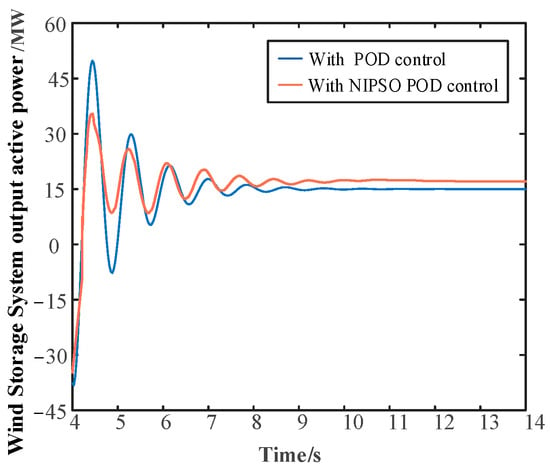
Figure 13.
Comparison of the active output of the wind storage system using POD and NIPSO POD controller.
The Figure 14 shows the power angle change curve of a single synchronous machine under the POD control of the original load and the POD control with POD control and parameter optimization at the 4 s and the POD control of the original load at the 4 s. Due to the limited power adjustment effect of the fan without POD control, the power angle of the generator changes significantly, and the amplitude oscillation occurs, and even leads to the system dissolution; Under the traditional PSO algorithm, POD control can reduce the oscillation amplitude, increase the oscillation frequency, and finally maintain the stability of the power angle. Under the improved PSO algorithm, POD control can further reduce the oscillation amplitude, the oscillation frequency is higher, and the ability to quickly restore the power angle is stronger. The effectiveness of the proposed controller and optimization algorithm in maintaining the stability of the power angle is verified.

Figure 14.
Comparison of the change of power angle of synchronous machine under three controls.
Table 6 is comparison of System Time Domain Performance Indexes under Three Controls. The rise time is the time required from the steady-state value to the peak value for the first time; the overshoot is the absolute value of the difference between the peak value and the steady-state value divided by the steady-state value; the adjustment time is the time required from the beginning to the oscillation reaching the 5% error of the steady state value for the first time.

Table 6.
Comparison of System Time Domain Performance Indexes under Three Controls.
The comparison results show that when the system is disturbed by the load, without any control, the power angle amplitude of the synchronous machine increases continuously, and the system becomes unstable; under the traditional PSO algorithm, the POD control can reduce the power angle oscillation amplitude, and finally maintain the power angle stability; POD control under the improved PSO algorithm makes the power angle oscillation curve rise longer, the overshoot smaller, the adjustment time shorter, and the fast recovery power angle stability stronger. It is verified that the POD control under the improved PSO algorithm is better than the POD control under the traditional PSO algorithm for suppressing low-frequency oscillations.
The Figure 15 shows the angular velocity variation curve of the rotor of a single synchronous machine without POD control and POD control with POD control and parameter optimization after adding a small load disturbance at the 4 s. Due to the limited power regulation effect of the wind storage system without POD control, the generator speed changes significantly, and amplitude oscillation occurs. Under the traditional PSO algorithm, POD control can reduce the angular velocity oscillation amplitude, increase the oscillation frequency, and finally maintain the stability of the generator speed. Under the improved PSO algorithm, the POD control can further reduce the oscillation amplitude, the oscillation frequency is higher, and the speed stability ability is stronger. The effectiveness of the proposed controller and optimization algorithm in maintaining speed stability is verified.
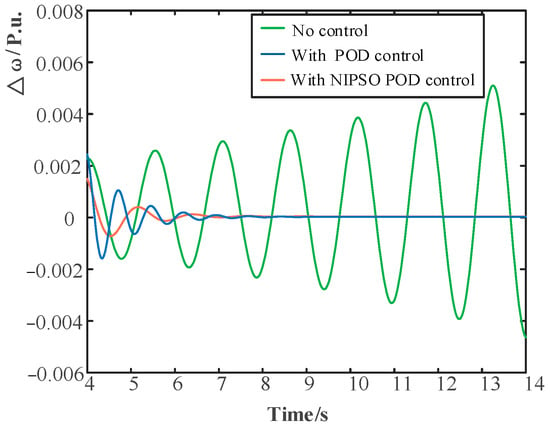
Figure 15.
Comparison of angular velocity changes of rotor of synchronous machine under three controls.
6. Conclusions
In this paper, aiming at the low-frequency oscillation problem caused by the access of wind power with energy storage to the power system, firstly, a small-signal model of the system considering the access of wind storage system is established, in order to find the oscillation mode, analyze the oscillation characteristics and study the low-frequency oscillation suppression measures; second, use power balance to design additional damping power oscillators to realize the regulation of the output active power of fans and energy storage, and select a unified coupling node signal as the input of the feedback signal, which can damp the power low-frequency oscillation when the load disturbance occurs; then, considering that the output power of the fan is limited by the wind speed, consider the additional damping power oscillator in the energy storage control part, and analyze the power angle characteristics and angular velocity changes of the system under different installation positions; finally, use Pareto and improved particle swarm optimization algorithm to improve the additional POD parameters of the low-frequency oscillation of the power system, and the simulation model is used to compare the results of uncontrolled mode, POD-based controlled mode and NIPSO-POD-based controlled mode. The simulation results verify the effectiveness of the proposed controller parameter optimization algorithm, that is, the NIPSO algorithm makes the design adaptability of the POD stronger, and significantly improves the suppression effect of the controller on low-frequency oscillation under the optimal parameters.
Author Contributions
Y.S.; methodology, software, validation. S.W.; Review, revise. All authors have read and agreed to the published version of the manuscript.
Funding
State Grid Shandong Electric Power Research Institute (4000-202316071A-1-1-ZN).
Institutional Review Board Statement
Not applicable for studies not involving humans or animals.
Informed Consent Statement
Not applicable.
Data Availability Statement
Data available on request due to restrictions e.g., privacy or ethical. The data presented in this study are available on request from the corresponding author. The data are not publicly available due to the process is complex.
Acknowledgments
Thanks to Li Jinyao, Zhao Weichen and Zhang Fan for their outstanding contributions in the completion of the article.
Conflicts of Interest
The authors declare no conflict of interest.
Appendix A
are stator winding d, q axis currents. are the transient potentials of the stator d and q axes. are the d and q axis components of the stator voltage. are d and q axis components of the rotor voltage. s is the slip rate. is the rotational angular velocity of the dq coordinate axis. The rest are intermediate variables.
References
- Liu, Y.; Wang, J.; Yue, Z. Improved Multi-point estimation method based probabilistic transient stability assessment for power system with wind power. Int. J. Electr. Power Energy Syst. 2022, 142, 108283. [Google Scholar] [CrossRef]
- Zhou, X.; Cheng, S.; Wu, X.; Rao, X. Influence of Photovoltaic Power Plants Based on VSG Technology on Low Frequency Oscillation of Multi-Machine Power Systems. IEEE Trans. Power Deliv. 2022, 37, 5376–5384. [Google Scholar] [CrossRef]
- Domínguez-García, J.L.; Gomis-Bellmunt, O.; Bianchi, F.D.; Sumper, A. Power oscillation damping supported by wind power: A review. Renew. Sustain. Energy Rev. 2012, 16, 4994–5006. [Google Scholar] [CrossRef]
- Du, W.; Bi, J.; Wang, T.; Wang, H. Impact of grid connection of large-scale wind farms on power system small-signal angular stability. CSEE J. Power Energy Syst. 2015, 1, 83–89. [Google Scholar] [CrossRef]
- Du, W.; Chen, X.; Wang, H.F. Impact of Dynamic Interactions Introduced by the DFIGs on Power System Electromechanical Oscillation Modes. IEEE Trans. Power Syst. 2017, 32, 4954–4967. [Google Scholar] [CrossRef]
- Song, D.; Yang, X.; Ding, Q.; Wang, Q. A survey on analysis on low frequency oscillation in large-scale interconnected power grid and its control measures. Power Syst. Technol. 2011, 35, 22–28. [Google Scholar]
- Bi, J.; Sun, H.; Guo, J.; Xu, S.; Yi, J.; Song, R. Influence of Dynamic Interaction Between Multiple DFIGs on Low Frequency Oscillation of Power System. In Proceedings of the 2019 IEEE Power & Energy Society General Meeting (PESGM), Atlanta, GA, USA, 4–8 August 2019; pp. 1–6. [Google Scholar]
- Ding, N.; Lu, Z.; Ying, Q.; Yong, M. Simplified equivalent models of large-scale wind power and the irapplication on small-signal stability. J. Mod. Power Syst. Clean Energy 2013, 1, 58–64. [Google Scholar] [CrossRef][Green Version]
- Du, W.; Bi, J.; Cao, J.; Wang, H.F. A Method to Examine the Impact of Grid Connection of the DFIGs on Power System Electromechanical Oscillation Modes. IEEE Trans. Power Syst. 2016, 31, 3775–3784. [Google Scholar] [CrossRef]
- Du, W.; Bi, J.; Wang, H.F. Small-signal angular stability of power system as affected by grid-connected variable speed wind generators—A survey of recent representative works. CSEE J. Power Energy Syst. 2017, 3, 223–231. [Google Scholar] [CrossRef]
- Yuan, B.; Zhou, M.; Li, G.; Zhang, X.-P. Stochastic Small-Signal Stability of Power Systems with Wind Power Generation. IEEE Trans. Power Syst. 2015, 30, 1680–1689. [Google Scholar] [CrossRef]
- Liu, H.; Sun, D.; Song, P.; Cheng, X.; Zhao, F.; Tian, Y. Influence of Virtual Synchronous Generators on Low Frequency Oscillations. CSEE J. Power Energy Syst. 2022, 8, 1029–1038. [Google Scholar]
- Huang, Y.; Chen, W.; Deng, X.; Tang, J.; Zhu, G.; Zhang, H. Modelling of DFIG-based wind turbine for low-frequency oscillation analysis of power system with high penetration of distributed energy. J. Eng. 2019, 2019, 2625–2628. [Google Scholar] [CrossRef]
- Dong, Q.; Sun, J.; Wu, Q.; Liu, Y. A Method for Filtering Low Frequency Disturbance in PMU Data Before Coordinated Usage in SCADA. IEEE Trans. Power Syst. 2017, 32, 2810–2816. [Google Scholar] [CrossRef]
- Wu, G.; Sun, H.; Zhao, B.; Xu, S.; Zhang, X.; Egea-Alvarez, A.; Wang, S.; Li, G.; Li, Y.; Zhou, X. Low-Frequency Converter-Driven Oscillations in Weak Grids: Explanation and Damping Improvement. IEEE Trans. Power Syst. 2021, 36, 5944–5947. [Google Scholar] [CrossRef]
- Li, S.; Zhang, H.; Yan, Y.; Ren, J. Parameter Optimization to Power Oscillation Damper (POD) Considering its Impact on the DFIG. IEEE Trans. Power Syst. 2022, 37, 1508–1518. [Google Scholar] [CrossRef]
- Quintero, J.; Vittal, V.; Heydt, G.T.; Zhang, H. The Impact of Increased Penetration of Converter Control-Based Generators on Power System Modes of Oscillation. IEEE Trans. Power Syst. 2014, 29, 2248–2256. [Google Scholar] [CrossRef]
- Li, S. Low-frequency oscillations of wind power systems caused by doubly-fed induction generators. Renew. Energy 2017, 104, 129–138. [Google Scholar] [CrossRef]
- Heffron, W.G.; Phillips, R.A. Effect of a Modern Amplidyne Voltage Regulator on Underexcited Operation of Large Turbine Generators [includes discussion]. Trans. Am. Inst. Electr. Engineers. Part III Power Appar. Syst. 1952, 71, 692–697. [Google Scholar] [CrossRef]
- Hong, H.; Jiang, Q.; Yan, Y. An Optimization Control Method of Battery Energy Storage System with Wind Power Fluctuations Smoothed in Real Time. Autom. Electr. Power Syst. 2013, 37, 103–109. [Google Scholar]
- Zhang, G.; Hu, W.; Cao, D.; Huang, Q.; Yi, J.; Chen, Z.; Blaabjerg, F. Deep Reinforcement Learning-Based Approach for Proportional Resonance Power System Stabilizer to Prevent Ultra-Low-Frequency Oscillations. IEEE Trans. Smart Grid 2020, 11, 5260–5272. [Google Scholar] [CrossRef]
Disclaimer/Publisher’s Note: The statements, opinions and data contained in all publications are solely those of the individual author(s) and contributor(s) and not of MDPI and/or the editor(s). MDPI and/or the editor(s) disclaim responsibility for any injury to people or property resulting from any ideas, methods, instructions or products referred to in the content. |
© 2023 by the authors. Licensee MDPI, Basel, Switzerland. This article is an open access article distributed under the terms and conditions of the Creative Commons Attribution (CC BY) license (https://creativecommons.org/licenses/by/4.0/).